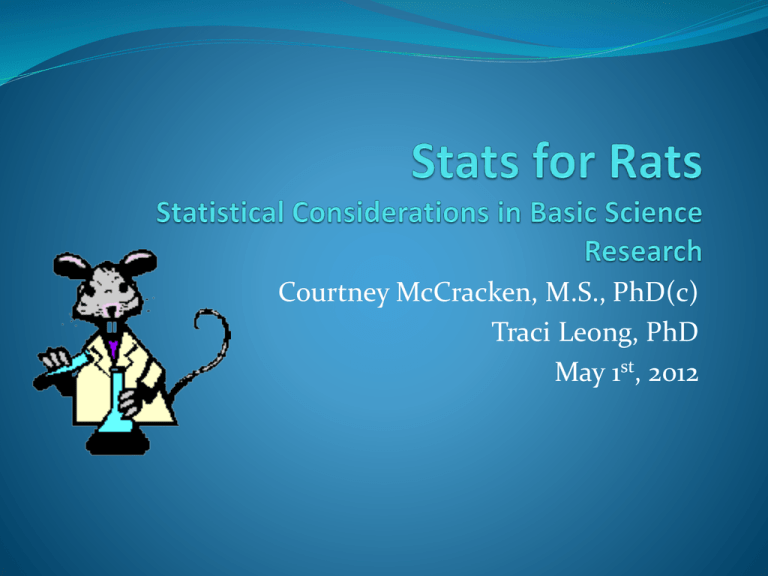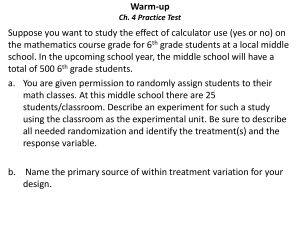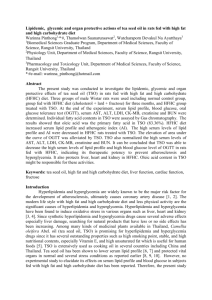Stats for Rats PowerPoint Slides
advertisement

Courtney McCracken, M.S., PhD(c) Traci Leong, PhD May 1st, 2012 Overview Biostatistics Core Basic principles of experimental design Sample size and power considerations Data management Biostatistics Core How to involve a biostatistician Go to: http://www.pedsresearch.org/cores/detail/biostats Fill out a request form under “How to Access” Biostatistics Core We provide an initial 1 hour session for any requested assistance. During this session, the scope of the request and needed resources are determined. The maximum number of fully subsidized hours per service is as follows: Grant Applications Manuscripts & Abstracts/Poster Presentations *Analysis for internal seed funds and pilot projects: 8 hours * Analysis towards manuscripts/ abstracts/posters to serve as foundation of grant application: 8 hours * Analysis towards manuscripts/ abstracts/posters that are not leading towards grant applications: 4 hours/investigator with a maximum of two times per year *Subsequent work on an intramurally funded project: 8 hours *Career Development Award applications: 12 hours *Analysis for mid-level projects, such as R21s, R01s and Foundation Grants: 16 hours 5 Basic principles of Experimental Design 1. Formulate study question/objectives in advance 2. Determine treatment and control groups or gold 3. 4. 5. 6. 6 standard Replication Randomization Stratification (aka blocking) Factorial experiments Formulate study question/objectives in advance Make sure your research questions are: Clear Achievable Relevant You have clearly defined: Response variable(s) Treatment/control groups Identified potential sources of variability Formulate study question/objectives in advance Multiple Response Variables Many trials/experiments measure several outcomes Must force investigator to rank them for importance Do sample size on a few outcomes (2-3) If estimates agree, OK…if not, must seek compromise Example Question: Does salted drinking water affect blood pressure (BP) in rats? Experiment: Provide a mouse with water containing 1% NaCl. 2. Wait 14 days. 3. Measure BP. 1. 9 Comparison/control Good experiments are comparative. • Compare BP in rats fed salt water to BP in rats fed plain water. • Compare BP in strain A rats fed salt water to BP in strain B rats fed salt water. • Note: parallel controls are preferable over historical controls • 10 Reduces variability Replication Performing same experiment under identical conditions Crucial in laboratory experiments Reduce the effect of uncontrolled variation Quantify uncertainty To assure that results are reliable and valid Replication can also introduce new sources of variability Example 15 rats were randomized to receive water containing 1% NaCl and 15 rats were randomized to receive water. 10 days later a new batch of 30 rats were ordered and the same experiment was performed. 96 well plates contain tissues samples from genetically identical rats. A solution is added to each of the well plates Replication 13 Replication Try to keep replicates balanced i.e., perform the same number of replicates per group/cluster For balanced designs, we can average replicates within a group/cluster together and compare group/cluster means Try to perform replication under the same day (if possible) to reduce any unexplainable variability due to day to day differences in experiments. Replication Ex. N=20 mice (10 per trt. group) Each mouse performs same experiment 4 times (e.g., 4 replicates). 4 x 20 = 80 observations (40 per group) You do NOT have 80 independent observations. You have 20 independent samples and within each sample you have 4 correlated observations. Ignoring the correlation within observations can bias results. 2 options: Average across 4 observations within subject and analyze means from each rat. Only works for balanced designs Take into account the correlation between observations by incorporating into statistical procedures. Randomization Experimental subjects (“units”) should be assigned to treatment groups at random. At random does not mean haphazardly. One needs to explicitly randomize using • A computer, or • Coins, dice or cards. 16 Importance of Randomization Avoid bias. For example: the first six rats you grab may have intrinsically higher BP. Control the role of chance. Randomization allows the later use of probability theory, and so gives a solid foundation for statistical analysis. 17 Stratification Suppose that some BP measurements will be made in the morning and some in the afternoon. If you anticipate a difference between morning and afternoon measurements: Ensure that within each period, there are equal numbers of subjects in each treatment group. Take account of the difference between periods in your analysis. This is sometimes called “blocking”. 18 Basic Statistics for Stratification Categorical Cochran Mantel-Haenszel Test Each strata has its own AxB contingency table Does the association between A and B, in each table, change as you move across each level of the strata Yes, then differences exists between strata No, no need for stratification and can collapse across strata Wild + Wild - D+ 20 0 D- 1 5 Wild + Wild D+ 5 10 D- 7 2 Males Females Basic Statistics for Stratification Continuous Analysis of Covariance (ANCOVA) Make a separate linear model for each level of the strata Compare and contrast slopes and y-intercepts Caution: Must check assumptions Analysis of Variance (ANOVA) Factorial experiments (see later slides) Example • 20 male rats and 20 female rats. • Half to be treated; the other half left untreated. • Can only work with 4 rats per day. Question? 21 How to assign individuals to treatment groups and to days? An extremely bad design 22 Randomized 23 A stratified design 24 Randomization and stratification If you can (and want to), fix a variable. e.g., use only 8 week old male rats from a single strain. If you don’t fix a variable, stratify it. e.g., use both 8 week and 12 week old male rats, and stratify with respect to age. If you can neither fix nor stratify a variable, randomize it. 25 Factorial Experiments Suppose we are interested in the effect of both salt water and a high-fat diet on blood pressure. Ideally: look at all 4 treatments in one experiment. Plain water Salt water Normal diet High-fat diet 2 factors with 2 levels each = 4 treatment groups Water + Normal Diet NaCl + Normal Diet Water + High-fat Diet NaCl + High-fat Diet 26 Factorial Experiments A factor of an experiment is a controlled independent variable; a variable whose levels are set by the experimenter or a factor can be a general type or category of treatments/conditions. Examples of factors in lab science research Treatment Time (Hour, Day, Month) Presence or absence of a biological characteristic D+ vs. DWild Type vs. Normal Factorial Experiments Adding additional factors leads to: Increased sample size Reduced Power Possible interactions (good and unexplainable) Additional complexity in modeling Why do a factorial experiment? We can learn more. More efficient than doing all single-factor experiments. Interactions 29 Statistics for Factorial Experiments ANOVA One-Way compare several groups of (independent) observations, test whether or not all the means are equal. 2 or more factors Test for presences of interactions first If significant report simple effects condition on each factor at a time If non-significant, remove from model and examine the main effects Note: balanced designs are preferable, same n in every group. Repeated Factors If you are measuring the same subject repeatedly then observations are not independent E.g., Measure BP at 1 hour, 2 hours, 4 hours after initiating treatment We must account for correlation between observations Try to only perform experiments with one-repeated factor. Increasing the # of repeated factors significantly increases the sample size (have to model large correlation structures which require n Other points Blinding Measurements made by people can be influenced by unconscious biases. Ideally, dissections and measurements should be made without knowledge of the treatment applied. Internal controls It can be useful to use the subjects themselves as their own controls (e.g., consider the response after vs. before treatment). Why? Increased precision. 32 Identifying the cut-off to use with a test on the basis of panel analysis: Real case Number of tests 25 Cut-off 20 False negatives 15 10 False positives True negatives Sick Well True positives 5 0 1 2 3 4 5 6 7 8 9 10 11 12 13 14 Possible values of the test Characteristics of a diagnostic test Sensitivity and specificity matter to laboratory specialists Studied on panels of positives and negatives Look into the intrinsic characteristics of the test: Capacity to pick affected Capacity to pick non affected Predictive values matter to clinicians Studied on homogeneous populations Look into the performance of the test in real life: What to make of a positive test What to make of a negative test Summary of Experimental Design Characteristics of good experiments: Unbiased Randomization Deliberate variation Blinding Factorial designs High precision Uniform material Replication Stratification Simple Protect against mistakes 35 Wide range of applicability Able to estimate uncertainty Replication Randomization 36 Significance test Compare the BP of 6 rats fed salt water to 6 rats fed plain water. = true difference in average 37 BP (the treatment effect). H0: = 0 (i.e., no effect) Test statistic, D. If |D| > C, reject H0. C chosen so that the chance you reject H0, if H0 is true, is 5% Distribution of D when = 0 Statistical power Power = The chance that you reject H0 when H0 is false (i.e., you [correctly] conclude that there is a treatment effect when there really is a treatment effect). 38 Power and sample size depend on… The design of the experiment The method for analyzing the data (i.e., the statistical 39 test) The size of the true underlying effect The variability in the measurements The chosen significance level () The sample size Effect of sample size 6 per group: Power = 70% 12 per group: Power = 94% 40 Effect of the effect = 8.5: Power = 70% = 12.5: Power = 96% 41 Various effects Desired power Stringency of statistical test sample size Measurement variability sample size Treatment effect 42 sample size sample size What do I need to a sample size / power calculation? Pilot Data Study Design List of variables interested in studying Proposal or basic summary of research goals Measure of the effect you want to detect for each research hypothesis Means and standard deviations for each group Odds Ratio between treatment and control group Expected proportion of event in each group Estimate of correlation between two variables General effect size you want to detect (most broad) Small <0.2; Moderate 0.2 – 0.5; Large >0.5 Reducing sample size I can’t afford 100 rats …. Reduce the number of treatment groups being compared. Find a more precise measurement (e.g., average time to effect rather than proportion sick). Decrease the variability in the measurements. Make subjects more homogeneous. Use stratification. Control for other variables (e.g., weight). Average multiple measurements on each subject. 44 Summary of Sample Size The things you need to know: • Structure of the experiment • Method for analysis • Chosen significance level, (usually 5%) • Desired power (usually 80%) • Variability in the measurements – if necessary, perform a pilot study, or use data from prior publications • The smallest meaningful effect 45 46 Database Management Capacity Emory Supported Good for small Studies Free Secure Best for longitudinal data Flexible Anyone can operate Web-based interface Microsoft Excel Microsoft Access REDCAP Database Design/ Data Entry Good Data Entry Practices 1. Determine the format of the database ahead of time a) b) One or two time points i. Short and Fat ii. Use only if a few measurements are duplicated Multiple Time Points (longitudinal) i. Long and Skinny 2. Variable names should be: a) b) Short but informative Have consistent nomenclature 3. Missing data should be left blank a) b) DO NOT use “99” or NA for missing data. Pay attention to variables < or > LOD Database Design/ Data Entry Good Data Entry Practices (continued) 4. Make sure the dataset is complete before sending it off to be analyzed. a) Adding/Deleting observations can greatly affect results and tables 5. Provide a key along with the database a) b) Defines numerical coding such as race categories or gender Identifies where important variables are located in the database 6. Avoid using multiple spreadsheets. a) Try to group as much information on one spreadsheet Database Design/ Data Entry Example 1 Short and Fat Best for prospective studies with little to no repeated measurements. Example 2 Long and Skinny Best for longitudinal or prospective studies with multiple repeated measurements or Example 3 Bad Example Common mistakes made. Questions? Acknowledgement This presentation was adapted from Karl Broman’s lecture on Experimental Data. This is part of a free lecture series from John Hopkins School of Public Health’s Open Courseware. For more information about additional lecture content from Dr. Broman please go to: http://ocw.jhsph.edu/courses/StatisticsLaboratoryScientistsI/lectureNotes.cfm










